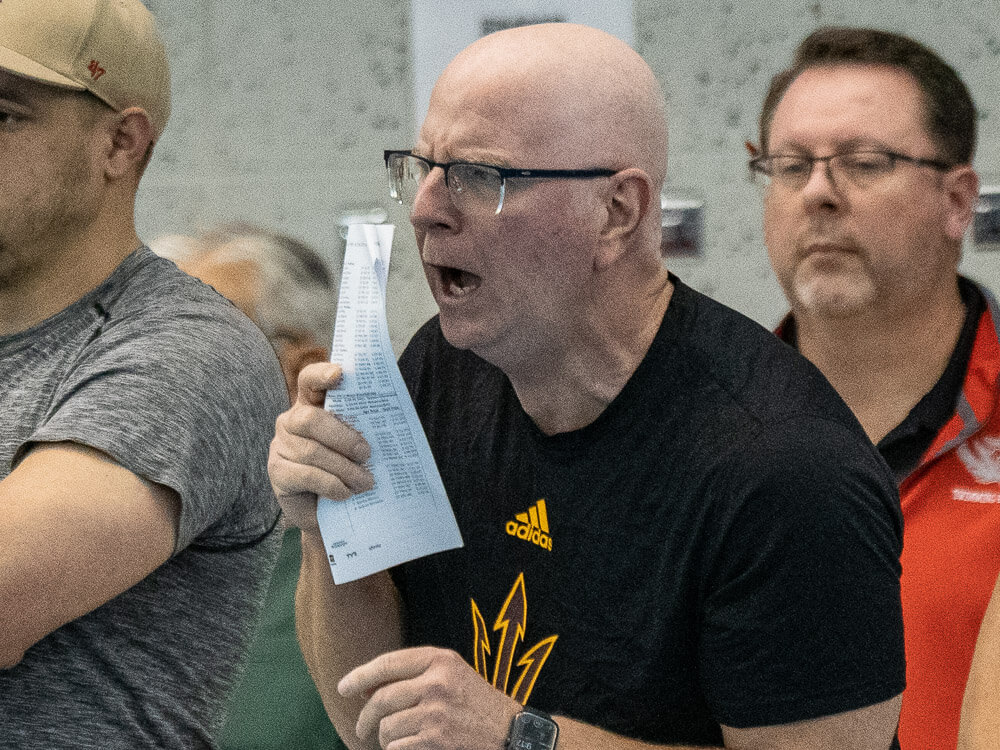Tech Tuesday: Arizona State Coach Bob Bowman on the Use of Tech Suits in Dual Meets

Tech Tuesday: Arizona State Coach Bob Bowman on the Use of Tech Suits in Dual Meets
In this edition of Tech Tuesday, we revisit a social-media post and conference-call comments made by Arizona State coach Bob Bowman late last year that sparked discussion and revealed the changing landscape of dual-meet competition in the collegiate ranks. Bowman emphasized the upside and reasoning for using tech suits in dual-meet action, and how this approach can be a positive for the sport.
***************************************
Late last season, as Arizona State was on its way to a runnerup finish to Cal at the NCAA Championships, Sun Devils coach Bob Bowman took to social media to challenge a longstanding thought process that could be limiting to collegiate athletes. On his Twitter account, Bowman wrote: “Pro and elite club swimmers wear tech suits for every race they swim. Why then, is it so frowned upon for college swimmers to wear tech suits in dual meets? Shouldn’t we rethink this? Asking for a friend.” 😈
Bowman’s commentary prompted an interesting and beneficial conversation that touched on several angles. For one, the legendary coach addressed the topic in which it has largely been considered taboo for a college team to “suit up” during dual-meet competition. Through Bowman’s eyes, why not allow the athletes to race at their fastest during the dual-meet season, or even in practice. Let them experience the benefits of technology and mimic the approach that will be used during the championship season.
When a handful of responses challenged Bowman’s thought process, suggesting cost as an impediment, the coach was ready with a rebuttal. Bowman, who mentored Michael Phelps to 28 Olympic medals, noted the opportunity to use the previous year’s tech suits for use in dual meets and practice. He also indicated there is a myth about the lifespan of tech suit, stating they endure for much longer than the swimwear companies want swimmers and coaches to believe.
The use of tech suits in dual meets obviously enables faster times, as opposed to practice suits which will limit optimum performance. As the sport looks for ways to grow itself, another plus of tech suits in dual meets is the opportunity to promote speed and peak performance. Fans want to see elite efforts, not neutralized showings.
ASU assistant coach Herbie Behm also weighed in on the topic with a key observation: “Removing suits lowers specificity by changing demands of the race. Task specificity should be considered in all exercises. Also, using meets as a “set-up” for future meets lowers cognitive specificity by shifting focus from ‘the now’ to a later date.”
A few days after his social-media post, Bowman further discussed the topic during a conference call.
“We decided to wear the tech suits because, No. 1, why don’t we want to go fast in meets?,” Bowman said. “Why do we impose slowness on ourselves when we don’t have to? We’d like to learn how to swim in the tech suits, and these meets are really the only time to learn how to do that, except for a couple of practices where we use them. We wanted to be able to do that under racing conditions. And No. 2, we also want to learn about our training plan. And if you’re going to go through your whole season without using the tech suits for the most part and then at the end, you’re going to add a tech suit, and shave and taper the training, there’s three variables you just changed and you don’t know which one made the difference or how much of a difference. So we’re taking one out of the equation. We’re going to know what the suits are doing for us, so we’ll have a much better idea of how we’re planning for the championship season and whether our taper was successful or not.”
Pro and elite club swimmers wear tech suits for every race they swim. Why then, is it so frowned upon for college swimmers to wear tech suits in dual meets? Shouldn’t we rethink this? Asking for a friend. 😈
— Bob Bowman (@coach_bowman) December 26, 2022




I’ve long maintained that creating situations for swimmers to swim slow (1) gives them a built in excuse for swimming slow. We can’t learn anything from competitive situations where the swimmer is allowed – and sometimes even encouraged to compete at a less than absolute level; and (2) banking on “taper” and/or a shave and a haircut + a tech suit, is like asking a basketball player to shoot a ball that weighs one ounce more, miss every shot all season long, and then expect the shots to miraculously go in at the big game.